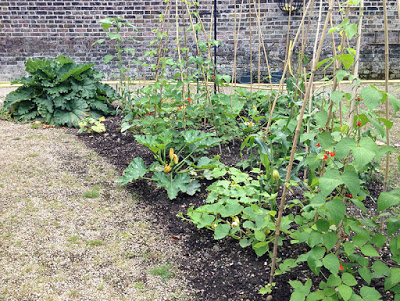Tuesday, 27 September 2016
Thursday, 22 September 2016
Beloved Lavender
Summer is almost gone, but the fantastic scent of lavender is still alive in the flowers we had cut and dried and it will be preserved in nice fabric bags for the next season and beyond.
The north wall of the Queen's Orchard has a colourful border of lavender in different shades of purple-blue, light blue, lilac, and also pink and white flowered spikes.
Each variety shows different characteristic in shape, colour, and also scent.
Hybrid varieties of Lavandula angustifolia such as "Grosso" can have longer spikes and a very strong scent, other varieties are shorter or have a lighter fragrance but they can be richer in colour as "Peter Pan" and "Hidcote" with their dark purple flowers. But if you are looking for some unusual colour you can have a look at the hybrid "Edelweiss" with its white spikes, or at the "Rosea" variety, the one with pink flowers, that also presents a quite sweet honey-like aroma.
Better be sure the variety you chose has the right characteristic you are looking for before plant it into your spot, anyway lavender is a gorgeous plant and can show its best in any kind of garden, from a formal bed to a country cottage border: for sure bees (and humans) will love it.
Last but not least: Lavender is also good for cooking, and we have a "lavender recipe" for you from the Pebble Soup's blog, enjoy it!
Lavender biscuits aka Cookies à la Lavande
Ingredients
125g butter (soften)
175g flour (sieved)
75g lavender sugar* or caster sugar with 1 small tablespoon lavender
2 drops of vanilla
Method
In a bowl mix the butter and sugar until fluffy (use a hand-mixer or fork)
Add the lavender sugar and the flour, mix it all together
Leave to rest in the fridge for 20 minutes.
Preheat the oven 200C = 180C fan = 400F = Gas mark 6
On a floured board, flatten the mixture and use a shaped cutter or a cookies press to make shapes.
Place the biscuits on a baking tray covered with baking parchement
After 8 minutes take a look and cook a little longer if necessary up to 12 minutes no more.
*Lavender sugar. To make your own, requires patience (a month of) but it's worth it, and makes nice presents. 1 tablespoon of lavender per 100g of caster sugar, seal in jars and leave for a month. Sieve it before using if you don't want the bit or use as such.
Wednesday, 7 September 2016
Three Sisters Planting System
Do you know that growing sweetcorn, beans, and squashes in the same field, or in the same bed like at the Queen's Orchard, can help you get the best from your crops?





This vegetable trio is known as the "Three Sisters System" or "Central America System"as these three plants are native to the New Continent and they are also strictly connected to the native american folklore representing three inseparable Sisters:
Corn, the oldest one, is also the tallest and can provide a support for bean vines to climb.
Squash, the second sister, reveals bright yellow flowers and her large leaves trap water evaporation from the soil; she is also a living mulch.
Bean, the third sister, has a mechanism whereby fixing nitrogen to her roots she can improve the fertility of the soil for the next year.
These three vegetable can also complement each other in terms of nutrition: corn is a source of carbohydrates, beans can provide protein, and squash is rich of vitamins and oil from seeds, a perfect balanced diet.
Speaking of balanced diet, food and vegetables: The Harvest Festival is coming!
On Sunday 2nd October from 11am to 4pm the Queen’s Orchard of Greenwich will be open to the public to celebrate the London Harvest Festival week with free activities and workshop for any age.
Save the date, and see you there at the Orchard!
Subscribe to:
Comments (Atom)
